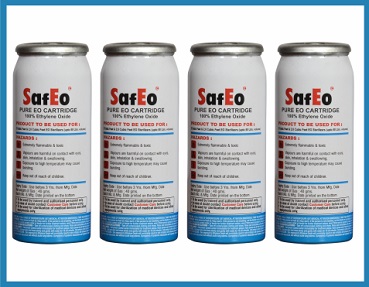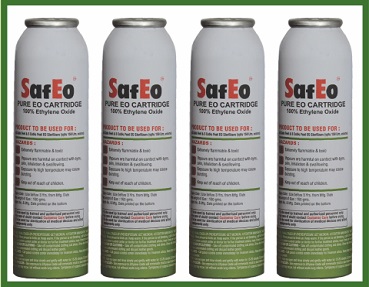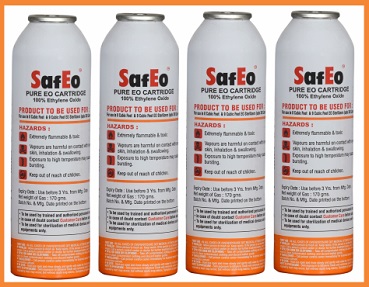About Ethylene Oxide Sterilisation
WHAT IS ETHYLENE OXIDE STERILISATION?
The traditional method of Sterilisation of surgical instruments has been by autoclaving and dry heating. But these methods are not suitable for sterilizing heat labile materials like plastic, rubber, electronic equipment, medicaments etc. owing to their being susceptible to high temperatures.
It is a proven fact, that ETHYLENE OXIDE ( E.O or EtO ) is an effective sterilizing agent at low temperature with good penetration power under desirable standards.
ETHYLENE OXIDE is a gas at ambient temperature since it vaporizes at 10.7 degrees centigrade; being an effective sterilizing agent, it destroys all micro-organisms at room temperature. Ethylene Oxide (EO) sterilises by alkylation . EO substitutes for Hydrogen atoms on molecules that are needed to sustain life and by attaching to these molecules , EO stops these molecules’ life supporting functions . Some of the key molecules that EO disrupts are protein and DNA.
PROPERTIES OF ETHYLENE OXIDE (E.O.)
Ethylene Oxide is toxic and highly flammable in nature. It is a colorless liquefied compressed gas with no distinct smell and is soluble in water. It is heavier than Air and has a Lower Explosive limit of 3% and a Higher Explosive Limit of 100% with a low flash point of (-15 degrees centigrade) which renders this gas, explosive and dangerous. E.O. is classified as a cancer and reproductive hazard. In case of fire, use Carbon Di - Oxide or dry chemical fire extinguishers. Burning of ethylene oxide is extinguished when diluted to 24 volumes with water.
- Boiling Point: 10.7 degrees centigrade
- Flammable Limits: Lower 3% (30,000 ppm), Upper 100%
- Ignition Temperature in Air: 428.9 degrees centigrade
- In Absence of Air: 571.1 degrees centigrade
- Solubility in Water: Completely soluble.
- Detectable Odor: After 500 – 750 ppm exposures.
FLAMMABLE
RESPIRATORY HAZARD
SKIN HAZARD
INGESTION HAZARD
TOXIC HAZARD
HEALTH HAZARD DATA
A. Ethylene oxide can cause bodily harm if you inhale the vapor, if it comes into contact with your eyes or skin, or if you swallow it.
B. Effects of overexposure:
- Ethylene oxide in liquid form can cause eye irritation and injury to the cornea, frostbite, and severe irritation and blistering of the skin upon prolonged or confined contact. Ingestion of EtO can cause gastric irritation and liver injury. Acute effects from inhalation of EtO vapors include respiratory irritation and lung injury, headache, nausea, vomiting,diarrhea, shortness of breath, and cyanosis (blue or purple coloring of skin). Exposure has also been associated with the occurrence of cancer, reproductive effects, mutagenic changes, neurotoxicity, and sensitization.
- EtO has been shown to cause cancer in laboratory animals and has been associated with higher incidences of cancer in humans. Adverse reproductive effects and chromosome damage may also occur from EtO exposure.
- Reporting signs and symptoms: You should inform your employer if you develop any signs or symptoms and suspect that they are caused by exposure to EtO.
EMERGENCY FIRST AID PROCEDURES
- Eye exposure: If EtO gets into your eyes, wash your eyes immediately with large amounts of water, lifting the lower and upper eyelids. Get medical attention immediately. Contact lenses should not be worn when working with this chemical.
- Skin exposure: If EtO gets on your skin, immediately wash the contaminated skin with water. If EtO soaks through your clothing, especially your shoes, remove the clothing immediately and wash the skin with water using an emergency deluge shower. Get medical attention immediately. Thoroughly wash contaminated clothing before reusing. Contaminated leather shoes or other leather articles should not be reused and should be discarded.
- Inhalation: If large amounts of EtO are inhaled, the exposed person must be moved to fresh air at once. If breathing has stopped, perform cardiopulmonary resuscitation. Keep the affected person warm and at rest. Get medical attention immediately.
- Swallowing: When EtO has been swallowed, give the person large quantities of water immediately. After the water has been swallowed, try to get the person to vomit by having him or her touch the back of the throat with his or her finger. Do not make an unconscious person vomit. Get medical attention immediately.
- Rescue: Move the affected person from the hazardous exposure. If the exposed person has been overcome, attempt rescue only after notifying at least one other person of the emergency and putting into effect established emergency procedures. Do not become a casualty yourself. Understand your emergency rescue procedures and know the location of the emergency equipment before the need arises.





